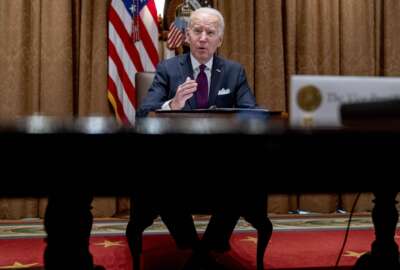Agencies get lots of new money to speed up infrastructure permits
Several agencies will get a part of $155 million from the Federal Permitting Improvement Steering Council. The money is aimed at helping agencies improve how they...
Several agencies will get a part of $155 million from the Federal Permitting Improvement Steering Council. The money is aimed at helping agencies improve how they review and decide on applications for infrastructure construction. For details, the Federal Drive with Tom Temin spoke with the council’s Executive Director Eric Beightel.
Interview Transcript:
Eric Beightel So the Inflation Reduction Act that was passed included $350 million for the permitting Council to improve overall efficiency, timeliness and predictability and performance of the permitting process. So that went into what we have as the Environmental Review Improvement Fund. And that is basically our operating budget, but also our kind of resources that we use to support agencies and state local governments and tribal entities to engage and improve on the overall permitting process. So this initial $155 million that was announced was really focused on the immediate needs of our agencies as they grapple with the sudden influx of permitting applications that are resulting from the signature investments of the [ Infrastructure Investment and Jobs Act (IIJA)] and the Inflation Reduction Act and the Chips and Science Act. So as we look across all of our agencies and as they engage on all of these large infrastructure projects, those applications are coming in at a volume that is unprecedented. And we have so many projects before us that we need to ensure that our agencies are effectively and adequately equipped to ensure that they can perform their functions appropriately and be timely in their decision making. So there’s $155 million that we are putting out is really focused on staff support, ensuring they have the human capital available to manage this influx of applications. We have a few millions that are going towards IT tools, but that really is kind of the focus of future investments. This initial investment was primarily by 80%, 85% of it was going strictly towards just staffing, just making sure we have the right ologists, biologists or ecologists or whatever that we need to do bird surveys or wetland delineation or folks that do mineral rights and ensuring that we are studying mineral rights agreements to help these construction operation plans for critical mineral mining to move them forward quicker. So it runs the full gamut of our infrastructure sectors that are covered by the Permitting Council, but it is really focused on the people at this point.
Tom Temin Got it. And this is then going divided among the 12 bureaus, agencies and in some cases, whole departments that are part of the council.
Eric Beightel That’s correct. All agencies did not receive funding. Many agencies also received funding directly from the Inflation Reduction Act to support environmental review. So the agencies that actually received funds in this tranche were the Department of Interior in many of its sub bureaus. Bureau of Land Management, Fish and Wildlife Service, Bureau of Ocean Energy Management, also the Department of Commerce with the [National Telecommunications and Information Administration (NTIA)], which does broadband work, as well as the Chip’s office, which is doing semiconductor work. And the [National Oceanic and Atmospheric Administration (NOAA)], which is responsible for Section seven consultations under the Endangered Species Act, but also marine mammal protection to ensure that they have the right people available to do those studies and do those consultations. The EPA also received funds for carbon capture sequestration projects. The ACHP, the Advisory Council on Historic Preservation received funds to hire new staff to just build the capacity for one of six consultations, which is their primary statute. The Department of Agriculture and Forest Service and Rural Utility Development Program also receive funds, as well as the Department of Homeland Security. So we had many, if not most, of our agencies that received funds, but not all. The process was really set up to ensure that we identified the agencies with the most immediate needs, and then target the investments so that we would have measurable improvements on the permanent timelines. And so we had negotiations and discussions with the agencies to ensure that the money was going where it would be most needed and best spent.
Tom Temin We’re speaking with Eric Beightel. He is executive director of the Federal Permitting Improvement Steering Council. And it’s great when guests are right on top of all the details like that. So we appreciate that rundown. And what do we know about the nature of the projects? I mean, this is not all windmills and solar farm sounds like.
Eric Beightel No. So there are two different types of kind of funds that were provided. We have some that are directed primarily at supporting the permitting for the projects that are covered under Fast 41. So our statute that authorizes us to extend coverage to certain types of infrastructure projects that are posted on the permitting dashboard. We have some funds that are going to agencies that will help them specifically to support permitting review for those types of projects. But then there’s other money that is going to a broader kind of general improvement in over 100 million of 155 is going towards just general improvement of permitting for infrastructure projects. And that’s not bound to the coverage sectors necessarily that are in Fast 41, but rather all of the work that we are doing and all of the infrastructure that needs to be built, we want to make sure that we have the capacity to expand or improve our efficiency on those projects as well.
Tom Temin Just as an aside, we should point out, I think as you did in our last interview, the council itself is not a creature of the infrastructure bill, but you go back actually to the Obama administration.
Eric Beightel That’s correct. So we were created in 2015 as part of the Fixing America’s Surface Transportation Act. It was an ad on Title 41 to that piece of legislation that created the agency, which is why we call this the Fast 41 process. We were still a very young agency comparatively to our peers, but we are trying to develop this agency into an entity that is very forward focused, service focused, customer oriented. And the use of these 350 million that Congress provided us to improve the overall performance of permitting is a critical tool to ensure the agencies have the resources they need to do the work necessary to deliver all these infrastructure projects.
Tom Temin So basically, you close the gap between shovel ready and permit ready.
Eric Beightel That’s one way to look at it. I think we are wanting to move these projects through the process effectively and we’re not cutting corners with the process, but rather just making sure that there’s enough butts in seats really to be able to handle the workload.
Tom Temin That was my next question, actually. Is there some process improvement or some way of changing things, or is the money just going to add people to brute force through old processes that are inefficient inherently?
Eric Beightel I think it’s a multi-pronged approach and kind of an all of government approach. The easy response is to add more people to handle the influx, but a longer term and more efficient potentially response is to improve processes and improve technology, to automate and to streamline some of these routine application reviews. So this is an initial 155 million that’s going out to the agencies to increase the human capital. But we are also taking a look at what are our long term investments for information technology that will allow us to do our jobs better and more efficiently. How can we incorporate artificial intelligence into some of the initial intake of applications? How can we improve interoperability among the agencies to share information? The Council on Environmental Quality, the Permanent Council and GSA are actually hosting an IT summit towards the end of the month where we’re going to convene a number of agencies and as well as external stakeholders to talk through like what’s the realm of the possible, where are the opportunities for us to make really targeted investments. It’s going to move the needle measurably long term. Hiring more people is absolutely essential. But it’s a Band-Aid when you take a longer view of improving the permitting process. There is so much more that we could do with people if we take out some of the routine activities and actually leverage their brainpower to be thinking creative and innovatively, let automation take care of some of the other stuff.
Tom Temin I imagine there is speaking of automation and artificial intelligence, there might be a way of speeding up things simply by triage, for example, of someone already has a power line and they want to add five cables to it, but otherwise there’s no other change to the landscape or anything. That’s one thing. On the other hand, if you want to clear 50 acres of forest and put up ten windmills, that’s something else entirely.
Eric Beightel That’s absolutely true. The environmental permitting regime, it’s really focused on the statutes look for impacts to particular resources. And NEPA, the National Environmental Policy Act is the umbrella statute tries to ensure that agencies take account for what their environmental effects are going to be for their investments and disclose those and make a decision based on public engagement and public input. But that is the complexity of the review and the length of time that it takes to get through all of those approvals, is really based on the complexity and the impact of the project, generally. So if you’re adding lines to an existing transmission line, if you’re just upgrading or adding additional capacity to it, that’s a much lower lip than a greenfield development of a new transmission line that’s going to cross multiple states and different counties and different biomes and whatever else there may be that’s going to have multiple permanent approvals. The alignment of those over time to ensure that if you get through state X and state Y has more difficult processes, if they’re not aligned, then you could get up to the border of state Y and then you’d be sunk. So making sure that we are working across borders to look at the big picture for these projects is absolutely critical.
Copyright © 2025 Federal News Network. All rights reserved. This website is not intended for users located within the European Economic Area.
Tom Temin is host of the Federal Drive and has been providing insight on federal technology and management issues for more than 30 years.
Follow @tteminWFED






